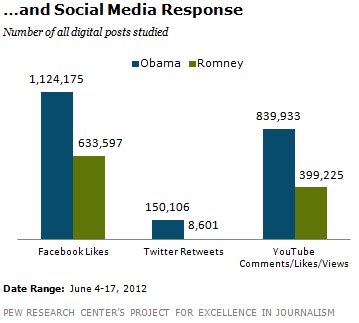Brands
Content Campaign ’12: Why Numbers Don’t Always Count
As part of the Content Campaign ’12 Series, The Content Strategist examines the content published by the presidential campaigns as part of their strategy to win November’s general election.
The Pew Research Center released 2012 election data this week shows that Barack Obama produces more content than Mitt Romney, but neither creates real conversations.

While it might be easy to call this content glut as a win for Obama, in content strategy, sheer numbers don’t always count. For the presidential candidates — and all content producers — more content can actually be less.
“More content and social activity does not necessarily mean better,” said Colleen Jones, author of Clout: The Art and Science of Influential Web Content, which features case studies from the 2008 presidential election.
The Pew study shows that Obama tweets on average 29 times for Romney’s one and is much more active on Youtube and his website than Romney. Romney is slightly more active on Facebook than Obama.
First and foremost, effective content strategy requires good content. Secondly, it involves finding the sweet spot between communicating too little and too much —what Ian Alexander, cofounder of digital content agency Eat Media, calls the “signal to noise ratio.”

There isn’t a set number of posts a candidate should make each day. Rather, Alexander said, “That balance is industry specific, campaign specific and reader specific.”
For instance, The Huffington Post tweets every five minutes. For The Huffington Post, the five minute mark is where sharing tweets plateaus.
But not everyone is the Huffington Post. For most news organizations that frequency of posts would lose followers or at least lose their attention.
In this case of Romney, communicating too little means his messages are at risk of being lost in the morass of social media.

“Tweeting once a day is like writing a letter and putting it in the mail,” Alexander said. “It will get there and maybe I’ll read it, but there’s a lot else going on.”
Romney’s impetus to increase tweets, however, shouldn’t be to match Obama. It should be to optimize his own content.
According to Jones, who is also the principal at the strategy consultancy Content Science, Romney’s campaign should focus on “timing and substance” to make its posts more meaningful.
Alternatively, on the other end, there’s the very likely possibility of communicating too much and becoming, as Alexander called it, “just noise.”

Think of junk mail. Once you know basically what those piles in your mailbox are going to be about, you start throwing them away, regardless of how awesome the deals might be. You no longer even look through them to see what they have to say.
Whether Obama’s 29 tweets a day is too much really depends on his following.
Because of the ways different audiences consume information, it’s important to keep tabs on them through analytics. Of course, shares and retweets always depend on the content — interesting posts will always go faster and farther — but pay attention to drop-offs in sharing when you tweet differently.
It’s important to be consistent with the frequency of the posts, but not the type of posts.
What’s important according to Alexander is varying content: changing post length, authorship and media.
So far in our series of analysis, we’ve seen that Obama has slightly more varied blog posts, slightly more engaging Twitter and more varied strategies in general.
But it isn’t a sweep.
It’s certainly not a ratio of 29 to 1.
Get better at your job right now.
Read our monthly newsletter to master content marketing. It’s made for marketers, creators, and everyone in between.




